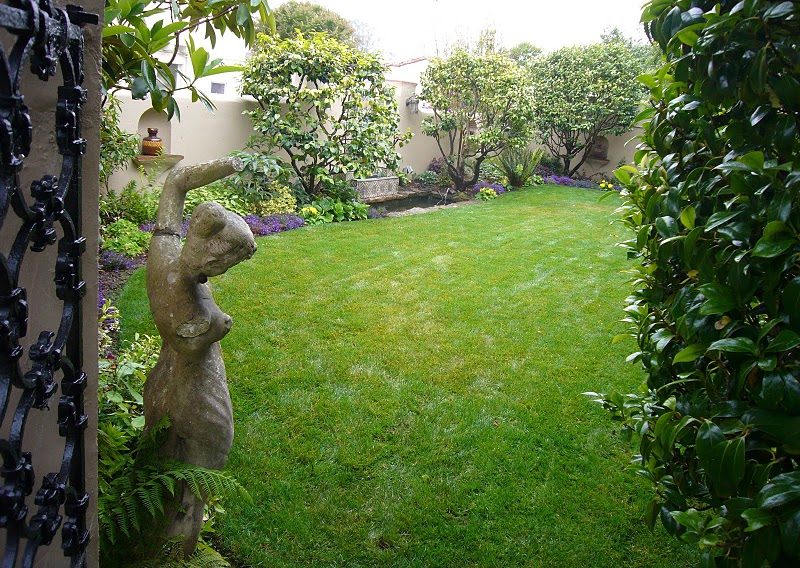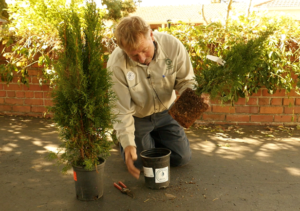
To reap the most enjoyment from your spring garden, you’ll need to know how to properly select and sow plants, trees, and turf. Photo: Artisan Landscape ©2019
Goodbye, April showers…hello, May flowers! As growing season hits its stride in the Bay Area, it’s the perfect time to augment your garden by adding new plants, trees and turf. However, to reap the best results, you’ll need to know how to properly select and sow these materials. To grow your knowledge, read the following tips from Diamond Certified Expert Contributors in the landscaping and tree service industries.
Selecting Plants and Trees
One of the biggest challenges of gardening is deciding which plants to install. To streamline this process, Laural Roaldson, owner of Laural Landscapes, Inc., recommends employing specific criteria. These should include your purpose for choosing the plant (shade, food, aesthetic beauty, etc.), its seasonal behavior (is it evergreen or deciduous?), and its watering and maintenance needs. “You should also consider the plant’s mature size,” adds Ms. Roaldson. “For example, a Coleonema may look cute as a seedling, but it’ll grow to three feet tall and six feet wide, so if you don’t want a plant that large, pick something else.”
Linda Gottuso-Guay of Manzanita Landscape Construction, Inc., says it’s also a good idea to consider environmental factors. “In addition to researching plants, take time to research the conditions in your yard; that way, you’ll know what kinds of plants will thrive there. Know your type of soil, how much sunlight and shade each area of your yard receives, and how wet or dry it gets. Pay attention to spots that are windy or exposed, poorly drained and hard to access—maintenance will be troublesome in these areas.”

One thing to check when selecting a tree is the condition of its root development. Photo: Gingrich Horticulture Service ©2019
In terms of tree selection, John Gingrich, owner of Gingrich Horticulture Service, offers a couple of tips. “Ideally, you should choose a tree that can stand on its own without being staked,” he says. “It has been proven that trees which can stand independently at the time of planting develop stronger root systems and branching structures than trees that rely on stakes.” Mr. Gingrich also recommends observing the condition of the tree’s roots and the size of its container. “When a large tree is contained in a small pot, it’ll likely be root-bound, which means the roots will be wrapped around several times. This condition can lead to problems after planting, so look for a tree that’s in an appropriately sized pot.”
Planting a Tree
When transplanting a new tree onto your property, small details can make all the difference for a healthy transition. “First, you need to dig a properly sized hole,” instructs Mr. Gingrich. “It should be about twice as wide as the tree’s diameter. This will ensure the soil surrounding the roots is soft and loose, which will give them room to develop. As for depth, when you set the tree into the hole, its root crown should be just above the soil level. This is critical because if the soil around the tree is too high, it can cause rot at its base.”
When backfilling your hole, Mr. Gingrich says it’s important to ensure the soil around the tree’s base is firm. “Tamp the soil as you go—you don’t want it to be too loose after planting, as the air pockets will create dry spots where the roots can’t grow. A little water can also help settle the soil.”
Once the tree is in the ground, Alex Llamas, owner of SexyTrees.com, recommends applying some mulch. “Mulch offers several benefits. It insulates the soil and keeps weeds down, and as it decomposes, the bacterial activity creates additional nutrients for the tree’s root system. Plus, it looks nice!” To get the full benefits of mulch, Mr. Llamas emphasizes correct application. “Mulch should be applied in a 4- to 6-inch layer around the tree’s outer root area. Don’t put it up against the tree’s base—the fungi and bacteria it creates can have a negative effect on the tree’s epidermis.”
Planting a Water-Wise Lawn
If you’re thinking about adding a new lawn to your yard, you may have concerns about irrigation—after all, lawns are notorious water guzzlers. However, according to Paul Singh, owner of Natural Landscaping Contractors, yours doesn’t have to be. “With a few guidelines, you can install a lawn that consumes far less water than the average,” he affirms. “By taking proactive measures before, during and after installation, you’ll be able to minimize its water consumption without diminishing its aesthetic qualities.”
Step one: Get the lawn area as level as possible. “Maintaining a slope of no more than 2 percent will minimize water run-off,” explains Mr. Singh. “Next, add compost and till the soil to a minimum depth of four to six inches. Once the bed is prepared, install sprinklers around the entire area to avoid any dry spots. For maximum water efficiency, choose rotary sprinkler heads instead of static heads— they have more flexibility for adjustments and emit water more slowly, which reduces water loss.”
After planting, Mr. Singh recommends giving your lawn about a month to get fully established. “It typically takes about 28 days for the turf roots to grow to a mature length,” he says. “This is crucial because the deeper the roots, the less water your lawn will require.” To avoid overwatering, he suggests getting a clear idea of how much your lawn really needs. “In most cases, three to four watering sessions per week is adequate. You should also fertilize your lawn three to four times a year, and patch and aerate it at regular intervals.”
